Industry transformer is essential to guarantee electricity for everybody, every building depends on a transformer to maintain continuous operations, for that reason is very important to maintain the safety and increase the transformer life cycle.
The control devices to maintain a transformer in good conditions normally are selected by the client according to the specifications or by the standards regulated by the manufacturer following always IEEE standards and other entities related as UL, CSA, IEC, NFPA, etc.
If you have not heard about these entities, please visit the next link and then back to this post.
During the post, you will see the next designation for every device.
| DEVICE NUMBER | DEVICE NAME |
|---|---|
| 26 | Apparatus thermal device |
To understand where came from please visit the next link:
Protection control devices used in a transformer
At the moment to build a transformer is coordinated basically for three engineers an Electrical Engineer, Mechanical Engineer, and Control Engineer. Every engineer guarantees the safety and optimal operation of the transformer combining their knowledge and expertise in the field selecting their own devices.
This post covers the elements most used in a transformer and some devices will be excluded because are special requirements normally order by the client or not related to a control device.
Oil temperature indicator (thermometer)
| DEVICE NUMBER | DEVICE NAME |
|---|---|
| 26 | Apparatus thermal device |
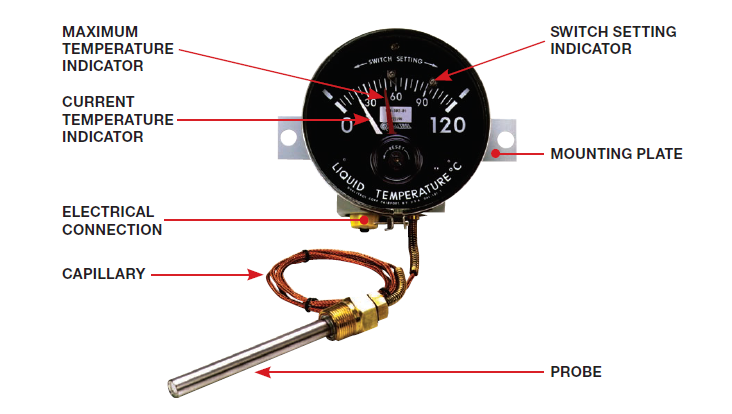
Temperature indicators are most commonly utilized for the indication of top oil or winding hotspot temperatures which are both critical parameters to measure within a transformer. They are commonly referred to in the industry as Oil Temperature Indicators (OTI) and Winding Temperature Indicators (WTI). Electrical utilities often utilize oil and winding temperature indicators to provide alarm and control signals that are used to activate cooling control systems on a transformer.
There are two basic types of thermometers:
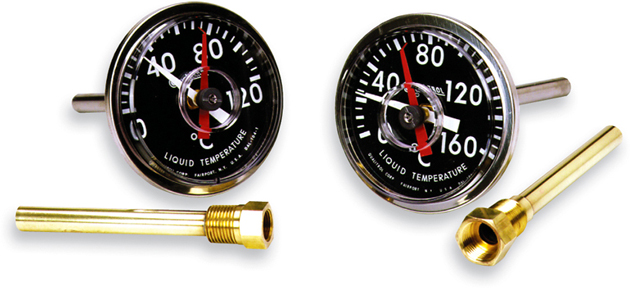
Direct Mount Transformer Thermometers are all-in-one devices mounted directly on the transformer tank. They are commonly located on a side wall (side mount) or on the top (top mount) of the transformer. The design is such that the temperature probe is inserted into a pocket (well) on the tank wall at the mounting point. A direct mount thermometer is fairly easy to identify, as it has a probe coming straight out the back of the device, with the temperature gauge on the front.
Direct mount OTI/WTI are generally chosen for smaller, lower voltage transformers where the temperature indicator can be submerged directly into the insulating oil. These units could be easily read by the user at eye level in the position where they are mounted. These temperature indicators are made using bi-metal technology. The principal behind them is the use of two dissimilar metals that expand at different rates to drive the indicating pointer on the dial.
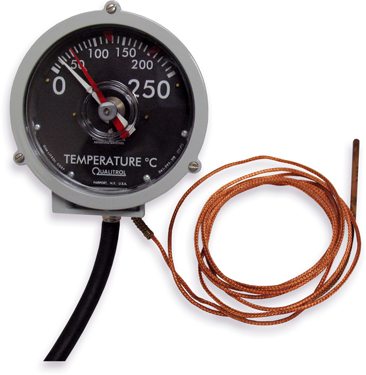
Remote Mount Transformer Thermometers separate the temperature probe from the visual gauge. The probe is inserted into a pocket (well) and a capillary tube connects the probe to the main device and visual indicator. The capillary tube is the easiest way to identify if you have a remote mount thermometer.
Remote mount OTI / WTI units are used for larger transformers where due to their size, the top oil well or pocket is not accessible from the ground, making it hard to see the temperature dial. The temperature sensing bulb is mounted in a pocket that is generally difficult to reach and the body of the indicator is mounted at eye level in another location on the transformer. A capillary connects the temperature sensing bulb and the body of the OTI / WTI indicator which includes the measurement dial. This capillary is filled with a fluid that expands as the temperature rises and moves an indication pointer on the face of the dial. The mechanism that drives the pointer is one of two technologies typically used for this application, either bellows-type or bourdon spring technology. Each has their own advantages and have been around for many decades. They both accomplish the same end goal of driving the temperature indication pointer.
Simulated Winding Temperature Sensors
Within remote mount thermometers, you could have a winding temperature thermometer. The winding temperature thermometer is going to have a coil that the probe goes into. That coil will be a heater coil that is tapped to a current tap off the transformer.
While top oil is a good indication of the highest temperature within the transformer tank, the overall temperature of the oil changes very slowly as it is an excellent insulator and has a large thermal mass. Simulating the winding temperature will give a more accurate idea of the temperature is inside the windings versus the top oil temperature. Transformer windings are where the heat is generated and therefore you will find the highest temperatures. Increased temperatures in the windings lead to accelerated aging and can signal a breakdown in the insulation or indicate a fault condition.
This includes simulation inside the device itself, through the use of a heated well or thermal plate.

The winding temperature can be simulated using the Current Transformer (CT) Current in various ways. The combination of oil temp (top and bottom) plus direct winding can provide a highly accurate thermal model for any power transformer.

Simulated winding temperature schemes are excellent because they can also be retrofit onto older transformers, not just installed at the time of manufacture like other hot spot solutions such as fiber optics.
In addition to traditional winding temperature indicators, the winding temperature can also be measured using a resistance temperature device (RTD).

These sensors can be used with the winding simulation methods mentioned above or with a power transformer monitor.

Fiber optic winding temperature sensors are an alternative option over traditional winding temperature indicators and are inserted into windings at the time of power transformer manufacturing. This is one of the most accurate ways to measure winding temperature in real-time.
Pressure Relief Device
| DEVICE NUMBER | DEVICE NAME |
|---|---|
| 63 | Pressure switch |
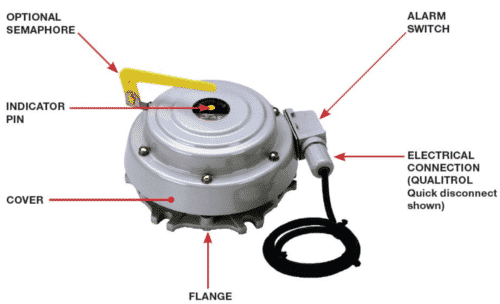
Pressure Relief Device is a device which is used for avoiding high oil pressure builds up inside the transformer during fault conditions. It is fitted on the top of the main tank. The PRD allows rapid release of excessive pressure that may be generated in the event of a serious fault. This device is fitted with an alarm/trip switch.

The PRD has a spring-loaded diaphragm, which provides rapid amplification of its actuating force and will reset automatically, as soon as the pressure inside the tank drops down to the pre-set pressure.
A bright colour coded mechanical indicator pin in the cover moves with the valve disc during the operation of the pressure relief device and is held in position by an ‘O’ ring in the pin bushing. This pin is clearly visible from ground level, which gives an indication that the device has operated.
The indicator pin may be reset manually by pushing it downward until it rests on the valve disc. The relief device is provided with a shielded weatherproof alarm /Trip and is operated by the movement of valve disc.
Sudden pressure relay

Internal arcing in an oil-filled power transformer can instantly vaporize surrounding oil, generating gas pressures that can cause catastrophic failure, rupture the tank, and spread flaming oil over a large area.
This can damage or destroy other equipment in addition to the transformer and presents extreme hazards to workers.
The relay is designed to detect a sudden pressure increase caused by arcing. It is set to operate before the pressure relief device. The control circuit should de-energize the transformer and provide an alarm. The relay will ignore normal pressure changes such as oil-pump surges, temperature changes, etc.

If this relay operates, do not re-energize the transformer until you have determined the exact cause and corrected the problem.
Liquid level indicators
| DEVICE NUMBER | DEVICE NAME |
|---|---|
| 71 | Liquid level switch |
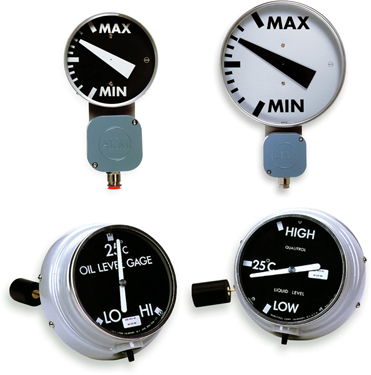
Having a clear indication of the oil level inside the tank of a transformer, the conservator and in the on-load tap changer provides important information about the condition of the transformer.
In order to identify the different types of transformer oil gauges, it helps to first understand their major components. Each gauge consists of three assemblies:
- The Case Assembly, which houses the dial (face) where you read the temperature, as well as the switches.
- The Flange Assembly, which consists of the flange that connects to the tank. The flange assembly also consists of the support tube, which extends from the back of the flange.
- The Float Rod Assembly, consisting of the float and float arm, which is supported by the flange assembly.
There are two main mounting types available for OLIs.
- Direct Mount oil level indicators
- Remote Mount oil level indicators
Most transformer oil level indicators are Direct Mount devices, meaning the case assembly, flange assembly and float rod assembly are a single integrated unit. These can be side mounted or top mounted.
Side mount OLIs generally have a float assembly that consists of a float on the end of a rotating arm. Whereas top mount OLIs (aka vertical oil level indicators) have a float within their vertical support tube.
Remote mount OLIs by contrast are designed for use where the point of measurement is not easily viewed by personnel, thus requiring separate or remote indication. For example on a conservator tank. In practice, this means the Case Assembly (with the visual dial) is separate from the Float Assembly, connected by a capillary tube.
Many modern oil level indicators have the case assembly magnetically coupled to the flange assembly. The advantage of this design is leak free operation. It makes it very easy to disassemble the OLI out in the field and replace the case assembly (swap it with another) when required.

Because these are magnetically coupled, you don’t run into the risk of needing to put the transformer offline or lower the oil level to change the case or do any maintenance work.
Remember the post covers the elements most used in a transformer and some devices will be excluded because are special requirements normally order by the client or not related to a control device, if some of the devices were missed and you would like to be included in this list please leave your comment.
Sources:
- Qualitrol
- Insulect
- Electrical Units
- Electrical Engineering portal
- C37.2-2008 – IEEE Standard Electrical Power System Device Function Numbers, Acronyms, and Contact Designations.
Posts related

